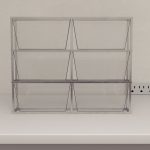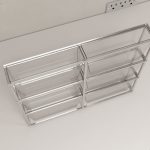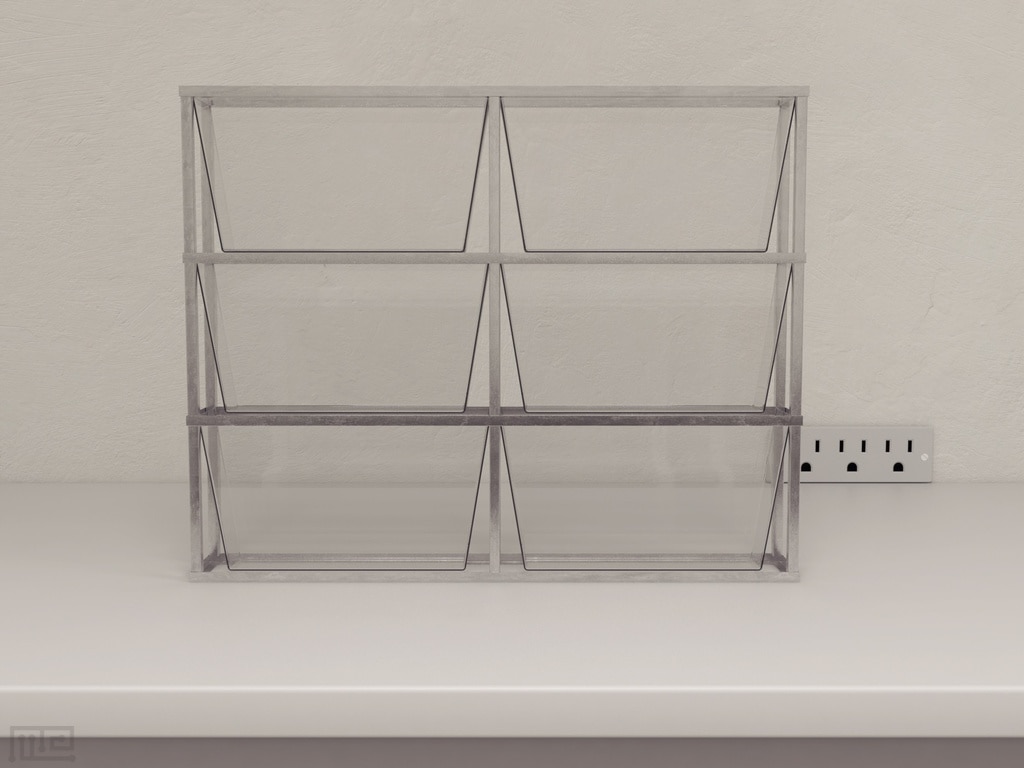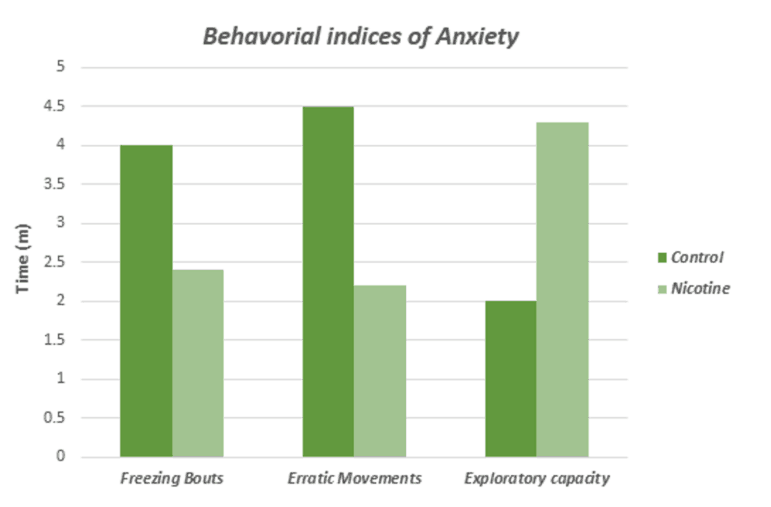Description
The MazeEngineers Vertical Tank Array is used for anxiety experiments for Zebrafish. Vertical diving behavior is used to assess anxiety in zebrafish. Narrow tanks minimize horizontal movement to maximize the behavior assessment.Each tank holds 1.5L in a trapezoid pattern. Set of 6 arrays come together with a housing apparatus for easy video grading.
Price & Dimensions
3 Tank Array
$ 1990
Per MonthIndividual Tank- Height: 15cm
- Length at top: 30cm
- Width at top: 7cm
- Length at bottom: 23cm
- Width at bottom: 6cm
6 Tank Array
$ 2990
Per Month- Individual Tank
- Height: 15cm
- Length at top: 30cm
- Width at top: 7cm
- Length at bottom: 23cm
- Width at bottom: 6cm
Documentation
Introduction
Zebrafish’s novel tank diving anxiety test is a widely used protocol to evaluate the behavioral indicators of anxiety manifested by reduced exploration, increased freezing behavior, and erratic movement.
Exposure to novelty induces anxiety responses in zebrafish (Cachat, J.M. et al. 2010) similar to rodents as in the rodent open field test.
The novel tank exploits the instinctive behavior of the zebrafish to find a safe place in an alien environment by diving and remaining at the bottom until they feel safe enough to explore. (Best, J.D. et al. 2008)
After gradual adaptation with the novel environment, the locomotion activity is increased significantly. This enhanced locomotion is manifested by increased movement, diminished freezing and more entries to the upper portion of the tank. (Wong, K, et al.2009; Stewart, A. et al.2010)
These responses are much similar to the rodent open test field, in which rodents depict anxiety-like behavior by residing near the walls (thigmotaxis), but after becoming less stressed move to the central area for exploration. (Choleris, E, et al., 2001; Bronikowski, A.M. et al. 2001)
Novel tank paradigm was developed by Edward D. Levin, Zachary Bencan et.al in 2006 for studying anxiolytic effects induced by nicotine in zebrafish.
The zebrafish model of nicotine effects is believed to play a significant role in determining nicotine addiction and remission. Their model also opened new avenues of analysis and research in nicotinic receptor mechanism.
Evaluation of anxiety in zebrafish is relatively a new concept. Peitsaro et.al established the concept that the zebrafish swim along the edges of the novel tank and previous experience in the environment reduce the time spent near the walls. However, they did not evaluate the vertical location choices of the subjects.
Later, Levin, Bencan et.al found out that evaluating vertical location choices provides reliable measure regarding the adaptation of zebrafish to the novel environment and the effect of drug treatments on adaptation to a novel environment.
Apparatus and Equipment
The apparatus consists of a plastic trapezoid tank, approx. 22.9 cm long at the bottom, 27.9 cm at the top, 15.2 cm high and 15.9 cm along the diagonal side.
The tank is wide at the top approx. 6.4 cm while narrowed to approx. 5.1 cm at the bottom.
The tank can hold up to 1.5 liters of water, and it should rest on a leveled stable surface.
The activity is recorded with the help of a video tracker such as Noldus Ethovision XT, which is placed approx. 51 cm from the apparatus.
Training Protocol
The purpose of the novel tank task is to evaluate behavioral indices of anxiety in zebrafish in a vehicle-treated control vs. disease model/intervention group, by assessing their swimming activity inside the novel tank.
Pretreatment for novel tank task
The subjects must be experimentally naive. Before testing, the subjects should be given at least 2 weeks to acclimate to the new environment. The water temperature is maintained at approximately 28.5 °C, and the subjects are kept in 12-12 hour light/dark cycle.
The subjects are usually housed in groups of 20-30 in home tanks containing recirculating deionized water, and fed with flakes or brine shrimp twice a day.
The subjects are transferred from their home tanks to the experimental room 1 hour before testing; to lessen crowding stress. There should be no more than four subjects per liter of water.
The subjects are then pretreated with the drug under consideration. Pretreatment time varies according to the drug and its dose. Mostly, the drug is administered about 10-30 minutes before testing for single (acute) treatment. The drug is administered either by immersion or intraperitoneal injection.
Evaluation of behavioral indices of anxiety
Before the start of the experiment, the novel tank is positioned in front of the Noldus Ethovision XT for ideal video recording. Ensure that almost every area of the tank is properly illuminated.
In multiple novel tank setups, each tank is separated by a colored opaque partition so that the subjects can’t see each other during the testing period.
The subjects are gently transferred into the novel tank by lifting them with the aid of a net (one fish at a time), gently steering the net to allow the fish to swim out. After the subject is introduced into the novel tank, the experiment is run for the desired length usually 5-6 minutes to evaluate the subject’s behavioral indicators of anxiety.
The time spent in each virtual zone horizontally and swim path length are considered as dependent measures. The choice of the position is taken as the index of anxiety.
Modifications
In the original version Edward D. Levin, Zachary Bencan et.al divided the tank into three, top, intermediate, and bottom virtual horizontal zones.
A significant modification of the novel tank paradigm was made by Jonathan Cachat et.al in 2010. They modified the task by dividing the tank into two virtual zones; namely, top and bottom to make the protocol more efficient in terms of measuring the zebrafish’s anxiety-like behavior.
The tank was divided into two equal virtual portions (horizontal), marked by a dividing line on the external walls of the tank.
Sample Data
The sample data compared the behavioral indices of anxiety in vehicle treated control group and drug administered (nicotine) group in terms of time. It is evident from the graph that nicotine caused decreased freezing bouts and erratic movements, whereas increased the exploratory capacity (locomotion) of the subjects under study.
Strengths & Limitations
Strengths
The novel tank anxiety task is an exceptional assay for drug screening as anxiety-like behavior can be regulated by anxiogenic and anxiolytic agents. (Egan, R.J. et al. 2009)
This model is an easy, economical and effective substitute for other methods that quantify stress responses in zebrafish.
The novel tank protocol is a useful paradigm for examining the array of neurobehavioral functions such as reward and cognitive function. (Bencan, Z, et al. 2009)
The task has enabled rapid evaluation and analysis of large amounts of data.
Limitations
The model fails to determine all anxiety behaviors like scototaxis or dark/light preference, and all behavioral domains like drug reward properties.
This protocol is suitable for studying anxiety-like behavioral aspects in adult zebrafish. Novel tank test is not applicable to larval zebrafish models.
Summary and Key Points
- The novel tank diving anxiety test is used to assess the behavioral indicators of anxiety manifested by reduced exploration, increased freezing bouts, and erratic movement.
- The apparatus consists of a plastic trapezoid tank.
- The time spent in each virtual zone horizontally and swim path length are considered as dependent measures. The choice of the position is recorded as the index of anxiety.
- Cachat et.al slightly modified the novel tank by dividing it into two virtual zones.
- The sample data constructed is the comparison of the behavioral indices of anxiety in vehicle treated control group and drug administered (nicotine) group.
References
Cachat, J.M. et al. Deconstructing adult zebrafish behavior with swim trace visualizations. In Zebrafish Neurobehavioral Protocols. (eds. Kalueff, A.V. & Cachat, J.) (Humana Press, Totowa, New Jersey, 2010).
Best, J.D. et al. Non-associative learning in larval zebrafish. Neuropsychopharmacology 33, 1206–1215 (2008).
Wong, K. et al. Analyzing habituation responses to novelty in zebrafish (Danio rerio). Behav. Brain Res. 208, 457 (2009).
Stewart, A. et al. The developing utility of zebrafish in modeling neurobehavioral disorders. Int. J. Comp. Psychol. 23, 104–121 (2010).
Choleris, E., Thomas, A.W., Kavaliers, M. & Prato, F.S. A detailed ethological analysis of the mouse open field test: effects of diazepam, chlordiazepoxide and an extremely low frequency pulsed magnetic field. Neurosci. Biobehav. Rev. 25, 235–260 (2001).
Bronikowski, A.M. et al. Open-field behavior of house mice selectively bred for high voluntary wheel-running. Behav. Genet. 31, 309–316 (2001).
Levin, E.D., Bencan, Z. & Cerutti, D.T. Anxiolytic effects of nicotine in zebrafish. Physiol. Behav. 90, 54–58 (2007)
Peitsaro N, Kaslin J, Anichtchik OV, Panula P. Modulation of the histaminergic system and behaviour by alpha-fluoromethylhistidine in zebrafish. J Neurochem 2003; 86:432–41.
Cachat J. et al. Measuring behavioral and endocrine responses to novelty stress in adult zebrafish. Nat. Protoc. 5, 1786–1799 (2010).
Egan, R.J. et al. Understanding behavioral and physiological phenotypes of stress and anxiety in zebrafish. Behav. Brain Res. 205, 38–44 (2009).
Bencan, Z., Sledge, D. & Levin, E.D. Buspirone, chlordiazepoxide and diazepam effects in a zebrafish model of anxiety. Pharmacol. Biochem. Behav. 94, 75–80 (2009).






